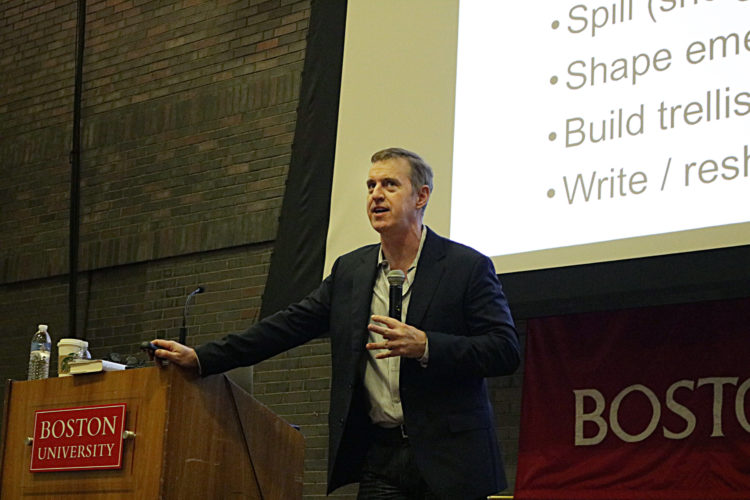Every story has a beginning, middle, and an end. But in the telling, stories don't necessarily conform to that neat order. For Dave Cullen, freelance journalist and bestselling author, there is plenty of room for creativity in this age-old writing convention.
Cullen’s book “Columbine” traces the April 1999 high school massacre in Littleton, Colorado, from an hour after the shootings, when Cullen arrived on the scene, through the following 10 years. In his search for answers — Why did the two high school classmates become killers? How does a community recover from such searing trauma? — he found that much of the known narrative about Columbine was wrong. That led to what has become something of a dark specialty for Cullen: the culture of gun violence and, more specifically, school shootings. His book “Parkland: Birth of a Movement” was published this February, based on rare access to the Florida high school students who refused to be silent victims in the face of carnage.

Cullen shared what he learned along the way about core story craft at the 2019 Power of Narrative conference at Boston University last month. His keynote focused on two of the nonfiction storyteller’s primary challenges: Structure and character.
When it came time to write “Columbine,” the 10-year span of reporting presented a major hurdle: There had been extensive media coverage, and most of his prospective readers already knew the basics of how things had played out on that horrific day and in the years that followed.
So Cullen had a difficult choice to make:
Put the climactic scene, where students Erik Harris and Dylan Klebold go on a murderous rampage, at the end of the book. The problem with that structure, Cullen said, is that as the rest of the story builds and builds, it sets readers up to wait for a dramatic payoff, like “violence porn.”
Or begin with that scene. That creates what Cullen affectionately referred to as the cliché of “Saving Private Ryan,” in which the most dramatic action all happens in the first 25 minutes of the plot, leaving the audience little incentive to watch the rest of the movie. If he opened his book with the school shooting, readers would have been immersed in the primary drama and might not be compelled to read the hundreds of pages that followed.
Either way, Cullen was confronted with a tension problem, which created a structural problem. His solution? He stood on the keynote stage at the Power of Narrative conference, and held up a piece of paper showing the classic story arc — akin to a bell curve: brief establishing exposition or scene, intense rising action, climax, falling action, resolution. Then he ripped the sheet half.
In that move, he demonstrated how, rather than picking one place for the climactic killing scene, he split it up, dispersing the action throughout the book.
“I get a lot of what I do from novels and films or cinema,” he said.
He opened his book in the days before the shootings, introducing some of the characters and foreshadowing some tension. When he gets to the morning of the shootings, he limits it to the moment the shooters get out of their cars and begin their rampage on the way into the school. Instead of having readers continue to follow them into the school, Cullen cuts to some exploration of the aftermath, only returning to the shootings in bits as he takes us through a more complex, multi-layered narrative. He followed that in-and-out timeline through the book, alternating pain and horror with humor and inspiring moments.
He also alternated the narratives of the killers and the victims. Cullen said his goal was to keep readers in suspense as he unspooled the story of the community reeling from the carnage.
That structural challenge was exacerbated by the challenge of character. Cullen wanted to tell the story of community response and recovery through individuals, but he had too many to choose from. There were 2,000 students at the school that day, and another 15,000 people in the community. In deciding how to select the right few to carry the story of many, he again borrowed a strategy from film. He selected people that best resembled typical character archetypes like “the good cop,” “the bad cop,” “the victim,” “the angry dad” and so on. Each character’s point of view was examined in alternating chapters. Together, they revealed the unfolding of a town healing from tragedy. That approach, he said, was borrowed from the use of multiple protagonists in William Faulkner’s “As I Lay Dying.”
Cullen’s solutions seem obvious — and maybe easy — in retrospect. But he said there are no easy solutions or set ways of doing things. “I don’t know what I want it to look like,” he said about the early stages of reporting and writing a book. “But I know what I want it to feel like and what I want it to convey to the reader.” That requires a lot of thinking, and a lot of trial and error. The walls of his writing office are covered in white boards filled with scribbles and sticky notes. “I have a vague idea and just fumble toward it,” he said: The beginning is often murky and the middle is “mucky.” But if you can fumble around to a good solution, the storytelling will be vivid.
“You don’t need to have a process and stick to it,” he said. “For God’s sake, don’t stick to anything.”
Cullen’s third book, “Soldiers First,” due out next year, is an account of two gay soldiers whose friendship carries them through two decades of war and changing military policy.
Boston University graduate student Jenny Rollins contributed to this story



